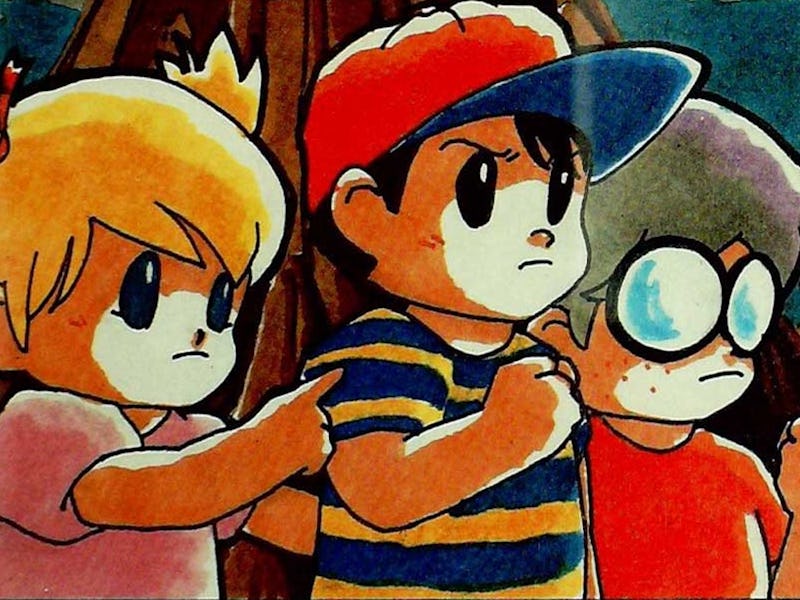How a Quirky RPG Changed the Course of Nintendo History
A literal game-changer thanks to its brilliant writing and devoted fanbase.

Big achievements cast long shadows. Think about some of pop culture’s greatest legends. James Gunn is revered for his superhero work like Guardians of the Galaxy, but no one talks about the equally-entertaining horror comedy Slither. It took years for the brilliant Futurama to escape the shadow of The Simpsons. In gaming, Nintendo is a household name built on household names like Mario, Zelda, and Donkey Kong. But 35 years ago, it released one of its most innovative, influential titles that’s never been more than a cult classic.
Mother released on July 25, 1989 in Japan. It was unlike any RPG anyone had ever seen. Not mechanically, as it employed the familiar turn-based attack systems, dialogue trees, and party development that are still the foundations of the genre today. What made Mother so radically different was its setting and its tone. It takes place in an idealized American-style suburb where a boy named Nintendo and his friends discover how their latent psychic abilities can help them solve a string of paranormal incidents. Imagine Stranger Things by way of SquareSoft. Full of humor and heart, Mother eventually spawned a franchise that found millions of fans, even though it got its start from an unlikely source: a copywriter.
The story behind Mother begins when famous copywriter Shigesato Itoi (basically the Don Draper of Japan) met with legendary producer Shigeru Miyamoto on a visit to Nintendo’s Kyoto HQ. Itoi loved the Dragon Quest series but felt like there was space in the genre for a setting beyond standard fantasy tropes. Itoi was an ideas man, but Miyamoto wasn’t impressed. Game development required a pragmatism Itoi wasn’t used to practicing and Miyamoto told him he had a nice concept but wasn’t anywhere close to having a plan in place for making a game.
“I was an amateur and didn’t really know what I was doing,” Itoi said in an interview shortly after the game’s release.
Itoi was passionate about the project, a welcome surprise for the team at Nintendo. Japan had seen a wave of celebrities treat video game launches as a quick cash grab, simply slapping their name on some half-cooked product so their fans could snatch it up. When Itoi began work on the project the expectation was he was only going to be around for a few meetings. That wasn’t his plan.
“If it meant pulling all-nighters like game developers do, I was fine with that. I intended to learn whatever I needed,” he said. “I was so enthusiastic that I would have done the most low-level work.”
The box art for Mother was inspired by the cover for Elvis Costello’s album Blood & Chocolate.
Fortunately, Itoi wasn’t put to work scrubbing toilets. His writing talents proved indispensable for the project, as Nintendo fans to this day hold up Mother and its subsequent games as the apex of video game script writing. NPCs often pontificated upon profound philosophical questions instead of just spitting plot points at you. Conversations felt real and meaningful as players pondered heady concepts like fate, heroism, and the cosmos writ large.
The quirky humor was leagues above what other games at the time were doing. For example, using the Check ability on enemies often reveals silly jokes about enemies. Bears are angry about their missing porridge, a Dust Ball’s text is simply “AHH-choooo!,” the enemy Foureyes is described as “the optometrist’s favorite!” Itoi is also credited with the legendary tagline “No crying until the ending.”
Mother was a top-ten selling title in Japan in 1989, and the popularity convinced Nintendo to localize the game for Western audiences. This is where the cult status for Mother begins, or as U.S. fans know it, Earth Bound.
The bright and whimsical charm of EarthBound enthralled a generation of gamers who still cherish the series to this day.
The original plan was for Earth Bound to release for the NES in 1991, but those plans fell through. Nintendo was worried about sales, as RPGs hadn’t quite taken hold of U.S. audiences yet, as well as doing a costly marketing promotion for an NES title so close to the release of the new SNES system. It became something of a white whale for emulation enthusiasts, with variations of prototype cartridges popping up online for years. It wasn’t officially released in the U.S. until 2015 under the title EarthBound Beginnings for the Wii U virtual console.
American fans did eventually get to experience the genre-defying franchise in 1994 when Mother 2 was localized for the SNES as EarthBound. It found a small but ferocious fanbase who fueled the decades-long search for the original localization and still churn out modern memes challenging Nintendo to “localize Mother 3.”
The memeing is Reggie.
The good news for fans is that both EarthBound Beginnings and EarthBound are available now on Nintendo Switch Online. Delving into either title showcases a franchise that was years ahead of its time. Its influence on the gaming scene, particularly indie RPGs, is obvious. It feels shockingly modern, especially if you compared it to other RPGs from the era. The writing holds up, the music is exquisite, and you get the sense you're experiencing a masterpiece. Just remember, no crying until the ending (when you realize you still can’t play Mother 3).